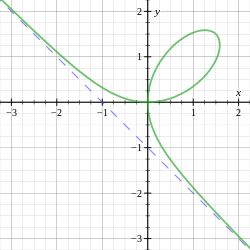Brill–Noether theory
In the theory of algebraic curves, Brill–Noether theory, introduced by Alexander von Brill and Max Noether (1874), is the study of special divisors, certain divisors on a curve C that determine more compatible functions than would be predicted. In classical language, special divisors move on the curve in a "larger than expected" linear system of divisors.
The condition to be a special divisor D can be formulated in sheaf cohomology terms, as the non-vanishing of the H1 cohomology of the sheaf of the sections of the invertible sheaf or line bundle associated to D. This means that, by the Riemann–Roch theorem, the H0 cohomology or space of holomorphic sections is larger than expected.
Alternatively, by Serre duality, the condition is that there exist holomorphic differentials with divisor ≥ −D on the curve.
Main theorems of Brill–Noether theory
For a given genus g, the moduli space for curves C of genus g should contain a dense subset parameterizing those curves with the minimum in the way of special divisors. One goal of the theory is to 'count constants', for those curves: to predict the dimension of the space of special divisors (up to linear equivalence) of a given degree d, as a function of g, that must be present on a curve of that genus.
The basic statement can be formulated in terms of the Picard variety Pic(C) of a smooth curve C, and the subset of Pic(C) corresponding to divisor classes of divisors D, with given values d of deg(D) and r of l(D) − 1 in the notation of the Riemann–Roch theorem. There is a lower bound ρ for the dimension dim(d, r, g) of this subscheme in Pic(C):
- dim(d, r, g) ≥ ρ = g − (r+1)(g − d+r)
called the Brill–Noether number.
For smooth curves C and for d≥1, r≥0 the basic results about the space Gr
d of linear systems on C of degree d and dimension r are as follows.
- George Kempf proved that if ρ≥0 then Gr
d is not empty, and every component has dimension at least ρ. - William Fulton and Robert Lazarsfeld proved that if ρ≥1 then Gr
d is connected. - Griffiths & Harris (1980) showed that if C is generic then Gr
d is reduced and all components have dimension exactly ρ (so in particular Gr
d is empty if ρ<0). - David Gieseker proved that if C is generic then Gr
d is smooth. By the connectedness result this implies it is irreducible if ρ > 0.
The problem formulation can be carried over into higher dimensions, and there is now a corresponding Brill–Noether theory for some classes of algebraic surfaces. Algebraic geometer Montserrat Teixidor i Bigas has written several papers about this topic, including "Brill–Noether Theory for stable vector bundles;[1] "A Riemann Singularity Theorem for generalized Brill–Noether loci";[2] "Brill–Noether theory for vector bundles of rank 2" [3] and "Brill–Noether theory for stable vector bundles".[4]
References
- Enrico Arbarello; Maurizio Cornalba; Philip A. Griffiths; Joe Harris (1985). Geometry of Algebraic Curves Volume I. Grundlehren der Mathematischen Wissenschaften 267. ISBN 978-0-387-90997-4.
- Brill, Alexander von; Noether, Max (1874). "Ueber die algebraischen Functionen und ihre Anwendung in der Geometrie". Mathematische Annalen. 7 (2): 269–316. doi:10.1007/BF02104804. JFM 06.0251.01. Retrieved 2009-08-22.
- Griffiths, Phillip; Harris, Joseph (1980). "On the variety of special linear systems on a general algebraic curve". Duke Mathematical Journal. 47 (1): 233–272. doi:10.1215/s0012-7094-80-04717-1. MR 0563378.
- Philip A. Griffiths; Joe Harris (1994). Principles of Algebraic Geometry. Wiley Classics Library. Wiley Interscience. p. 245. ISBN 978-0-471-05059-9.
- ↑ Grzegorczyk, Ivona; Bigas, Montserrat Teixidor I (2008). "Brill-Noether Theory for stable vector bundles". arXiv:0801.4740 [math.AG].
- ↑ Teixidor, Montserrat (1998). "A Riemann Singularity Theorem for Generalised Brill - Noether Loci". Mathematische Nachrichten. 196 (1): 251–257. doi:10.1002/mana.19981960111.
- ↑ Brill–Noether theory for vector bundles of rank 2
- ↑ Brill–Noether theory for stable vector bundles
